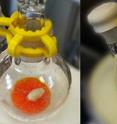Snapshots of chemical reactions: Characterizing an important reactive intermediate
Related images
(click to enlarge)
An international group of researchers led by Dr. Warren E. Piers (University of Calgary) and Dr. Heikki M. Tuononen (University of Jyväskylä) has been able to isolate and characterize an important chemical intermediate whose existence has, so far, only been inferred from indirect experimental evidence. Chemical reactions rarely go from starting materials to final products in one single step, but instead they progress through a number of intermediates. In many cases the intermediates are not stable enough to be studied by conventional characterization methods, which thwarts efforts to understand reaction mechanisms. In the present case, the research group of Dr. Piers was able to undertake a comprehensive solution and solid-state characterization of an adduct between a Lewis acidic perfluoroarylborane and an electron-rich silane that has been postulated to be an intermediate in the 'frustrated' Lewis-pair hydrosilylation of C=C, C=O and C=N double bonds.
"The results of this paper are important because we now know more about the mechanistic details of a significant chemical reaction," says Dr. Piers, a Tier I Canada Research Chair at the University of Calgary. "It is like travelling along the trans-Canada highway from Victoria to St. John's always blindfolded and finally being able to see the Rockies along the way: a breathtaking moment," he explains.
However, characterizing an important reaction intermediate is only half of the story. Equally important is to understand what factors contribute to its stability and by how much. Here the research group of Academy Research Fellow Dr. Tuononen comes into play with the tools of theoretical modelling.
"Computational work showed that this is a good example of the Goldilocks effect in chemistry: everything needs to be 'just right'," tells Dr. Tuononen. "The calculations not only pinpoint the important contributors to the stability but also enable us to use this information to design similar adducts that are even more stable. This way we can study them experimentally in greater detail for further insight into the underlying chemistry."
Source: Academy of Finland
Other sources
- Snapshots of chemical reactions: Characterizing an important reactive intermediatefrom Science DailyThu, 2 Oct 2014, 4:01:53 UTC
- Characterizing an important reactive intermediatefrom PhysorgWed, 1 Oct 2014, 11:00:53 UTC
